CUC100 Annotated Bibliography: Sustainability Science
VerifiedAdded on 2022/07/28
|5
|1172
|49
Annotated Bibliography
AI Summary
This annotated bibliography for the CUC100 course presents summaries and commentaries of key readings related to sustainability science. The bibliography includes an analysis of the evolution of sustainability models, focusing on the three pillars framework (technology and innovation, laws and governance, and economics and financial incentives), and its application in addressing complex sustainability issues. The assignment also explores the concept of developing awareness of sustainability, using the sustainability triad (economic, social, and environmental) as a teaching tool, and the impact of climate change on various aspects, including groundwater resources and crop production. The annotated entries highlight the importance of understanding sustainability in a concrete manner and the need for implementing regulations to mitigate climate change risks. The articles discuss the evolution of sustainability models, the importance of technology, governance, and economics, and the implications of climate change on society and the environment. The bibliography also includes discussions on the sustainability triad and its application in understanding the dimensions of sustainability.
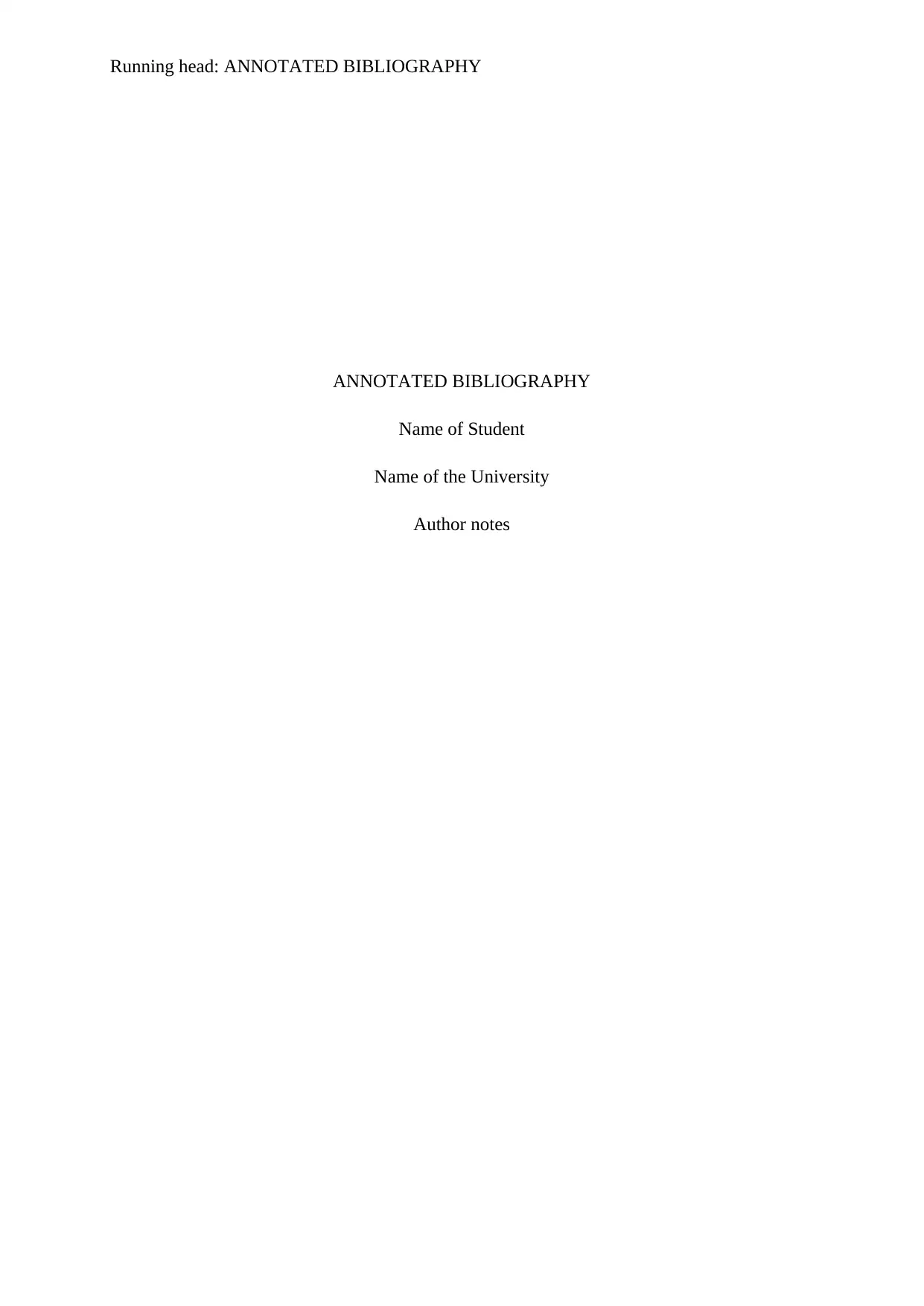
Running head: ANNOTATED BIBLIOGRAPHY
ANNOTATED BIBLIOGRAPHY
Name of Student
Name of the University
Author notes
ANNOTATED BIBLIOGRAPHY
Name of Student
Name of the University
Author notes
Paraphrase This Document
Need a fresh take? Get an instant paraphrase of this document with our AI Paraphraser
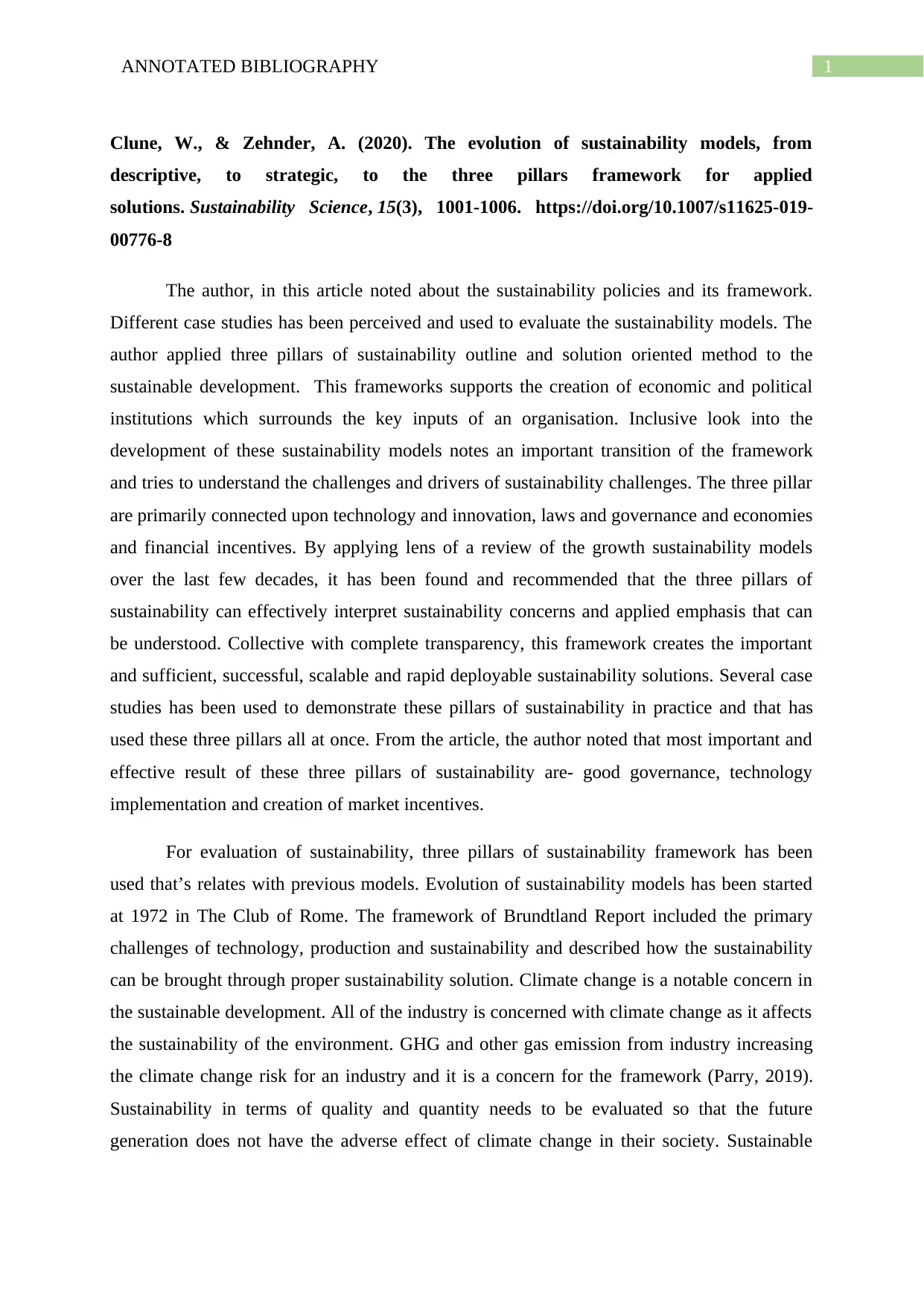
1ANNOTATED BIBLIOGRAPHY
Clune, W., & Zehnder, A. (2020). The evolution of sustainability models, from
descriptive, to strategic, to the three pillars framework for applied
solutions. Sustainability Science, 15(3), 1001-1006. https://doi.org/10.1007/s11625-019-
00776-8
The author, in this article noted about the sustainability policies and its framework.
Different case studies has been perceived and used to evaluate the sustainability models. The
author applied three pillars of sustainability outline and solution oriented method to the
sustainable development. This frameworks supports the creation of economic and political
institutions which surrounds the key inputs of an organisation. Inclusive look into the
development of these sustainability models notes an important transition of the framework
and tries to understand the challenges and drivers of sustainability challenges. The three pillar
are primarily connected upon technology and innovation, laws and governance and economies
and financial incentives. By applying lens of a review of the growth sustainability models
over the last few decades, it has been found and recommended that the three pillars of
sustainability can effectively interpret sustainability concerns and applied emphasis that can
be understood. Collective with complete transparency, this framework creates the important
and sufficient, successful, scalable and rapid deployable sustainability solutions. Several case
studies has been used to demonstrate these pillars of sustainability in practice and that has
used these three pillars all at once. From the article, the author noted that most important and
effective result of these three pillars of sustainability are- good governance, technology
implementation and creation of market incentives.
For evaluation of sustainability, three pillars of sustainability framework has been
used that’s relates with previous models. Evolution of sustainability models has been started
at 1972 in The Club of Rome. The framework of Brundtland Report included the primary
challenges of technology, production and sustainability and described how the sustainability
can be brought through proper sustainability solution. Climate change is a notable concern in
the sustainable development. All of the industry is concerned with climate change as it affects
the sustainability of the environment. GHG and other gas emission from industry increasing
the climate change risk for an industry and it is a concern for the framework (Parry, 2019).
Sustainability in terms of quality and quantity needs to be evaluated so that the future
generation does not have the adverse effect of climate change in their society. Sustainable
Clune, W., & Zehnder, A. (2020). The evolution of sustainability models, from
descriptive, to strategic, to the three pillars framework for applied
solutions. Sustainability Science, 15(3), 1001-1006. https://doi.org/10.1007/s11625-019-
00776-8
The author, in this article noted about the sustainability policies and its framework.
Different case studies has been perceived and used to evaluate the sustainability models. The
author applied three pillars of sustainability outline and solution oriented method to the
sustainable development. This frameworks supports the creation of economic and political
institutions which surrounds the key inputs of an organisation. Inclusive look into the
development of these sustainability models notes an important transition of the framework
and tries to understand the challenges and drivers of sustainability challenges. The three pillar
are primarily connected upon technology and innovation, laws and governance and economies
and financial incentives. By applying lens of a review of the growth sustainability models
over the last few decades, it has been found and recommended that the three pillars of
sustainability can effectively interpret sustainability concerns and applied emphasis that can
be understood. Collective with complete transparency, this framework creates the important
and sufficient, successful, scalable and rapid deployable sustainability solutions. Several case
studies has been used to demonstrate these pillars of sustainability in practice and that has
used these three pillars all at once. From the article, the author noted that most important and
effective result of these three pillars of sustainability are- good governance, technology
implementation and creation of market incentives.
For evaluation of sustainability, three pillars of sustainability framework has been
used that’s relates with previous models. Evolution of sustainability models has been started
at 1972 in The Club of Rome. The framework of Brundtland Report included the primary
challenges of technology, production and sustainability and described how the sustainability
can be brought through proper sustainability solution. Climate change is a notable concern in
the sustainable development. All of the industry is concerned with climate change as it affects
the sustainability of the environment. GHG and other gas emission from industry increasing
the climate change risk for an industry and it is a concern for the framework (Parry, 2019).
Sustainability in terms of quality and quantity needs to be evaluated so that the future
generation does not have the adverse effect of climate change in their society. Sustainable
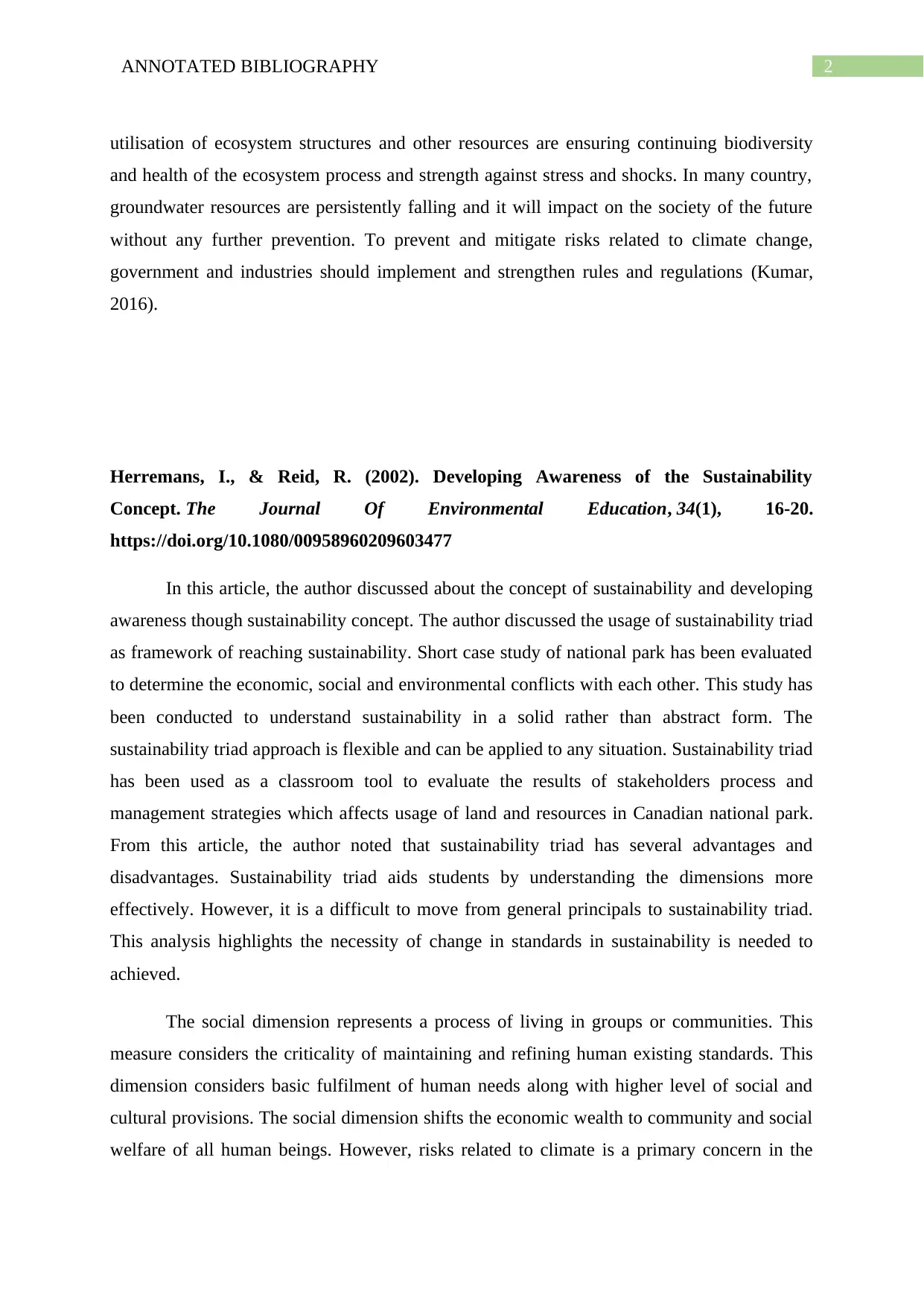
2ANNOTATED BIBLIOGRAPHY
utilisation of ecosystem structures and other resources are ensuring continuing biodiversity
and health of the ecosystem process and strength against stress and shocks. In many country,
groundwater resources are persistently falling and it will impact on the society of the future
without any further prevention. To prevent and mitigate risks related to climate change,
government and industries should implement and strengthen rules and regulations (Kumar,
2016).
Herremans, I., & Reid, R. (2002). Developing Awareness of the Sustainability
Concept. The Journal Of Environmental Education, 34(1), 16-20.
https://doi.org/10.1080/00958960209603477
In this article, the author discussed about the concept of sustainability and developing
awareness though sustainability concept. The author discussed the usage of sustainability triad
as framework of reaching sustainability. Short case study of national park has been evaluated
to determine the economic, social and environmental conflicts with each other. This study has
been conducted to understand sustainability in a solid rather than abstract form. The
sustainability triad approach is flexible and can be applied to any situation. Sustainability triad
has been used as a classroom tool to evaluate the results of stakeholders process and
management strategies which affects usage of land and resources in Canadian national park.
From this article, the author noted that sustainability triad has several advantages and
disadvantages. Sustainability triad aids students by understanding the dimensions more
effectively. However, it is a difficult to move from general principals to sustainability triad.
This analysis highlights the necessity of change in standards in sustainability is needed to
achieved.
The social dimension represents a process of living in groups or communities. This
measure considers the criticality of maintaining and refining human existing standards. This
dimension considers basic fulfilment of human needs along with higher level of social and
cultural provisions. The social dimension shifts the economic wealth to community and social
welfare of all human beings. However, risks related to climate is a primary concern in the
utilisation of ecosystem structures and other resources are ensuring continuing biodiversity
and health of the ecosystem process and strength against stress and shocks. In many country,
groundwater resources are persistently falling and it will impact on the society of the future
without any further prevention. To prevent and mitigate risks related to climate change,
government and industries should implement and strengthen rules and regulations (Kumar,
2016).
Herremans, I., & Reid, R. (2002). Developing Awareness of the Sustainability
Concept. The Journal Of Environmental Education, 34(1), 16-20.
https://doi.org/10.1080/00958960209603477
In this article, the author discussed about the concept of sustainability and developing
awareness though sustainability concept. The author discussed the usage of sustainability triad
as framework of reaching sustainability. Short case study of national park has been evaluated
to determine the economic, social and environmental conflicts with each other. This study has
been conducted to understand sustainability in a solid rather than abstract form. The
sustainability triad approach is flexible and can be applied to any situation. Sustainability triad
has been used as a classroom tool to evaluate the results of stakeholders process and
management strategies which affects usage of land and resources in Canadian national park.
From this article, the author noted that sustainability triad has several advantages and
disadvantages. Sustainability triad aids students by understanding the dimensions more
effectively. However, it is a difficult to move from general principals to sustainability triad.
This analysis highlights the necessity of change in standards in sustainability is needed to
achieved.
The social dimension represents a process of living in groups or communities. This
measure considers the criticality of maintaining and refining human existing standards. This
dimension considers basic fulfilment of human needs along with higher level of social and
cultural provisions. The social dimension shifts the economic wealth to community and social
welfare of all human beings. However, risks related to climate is a primary concern in the
⊘ This is a preview!⊘
Do you want full access?
Subscribe today to unlock all pages.

Trusted by 1+ million students worldwide
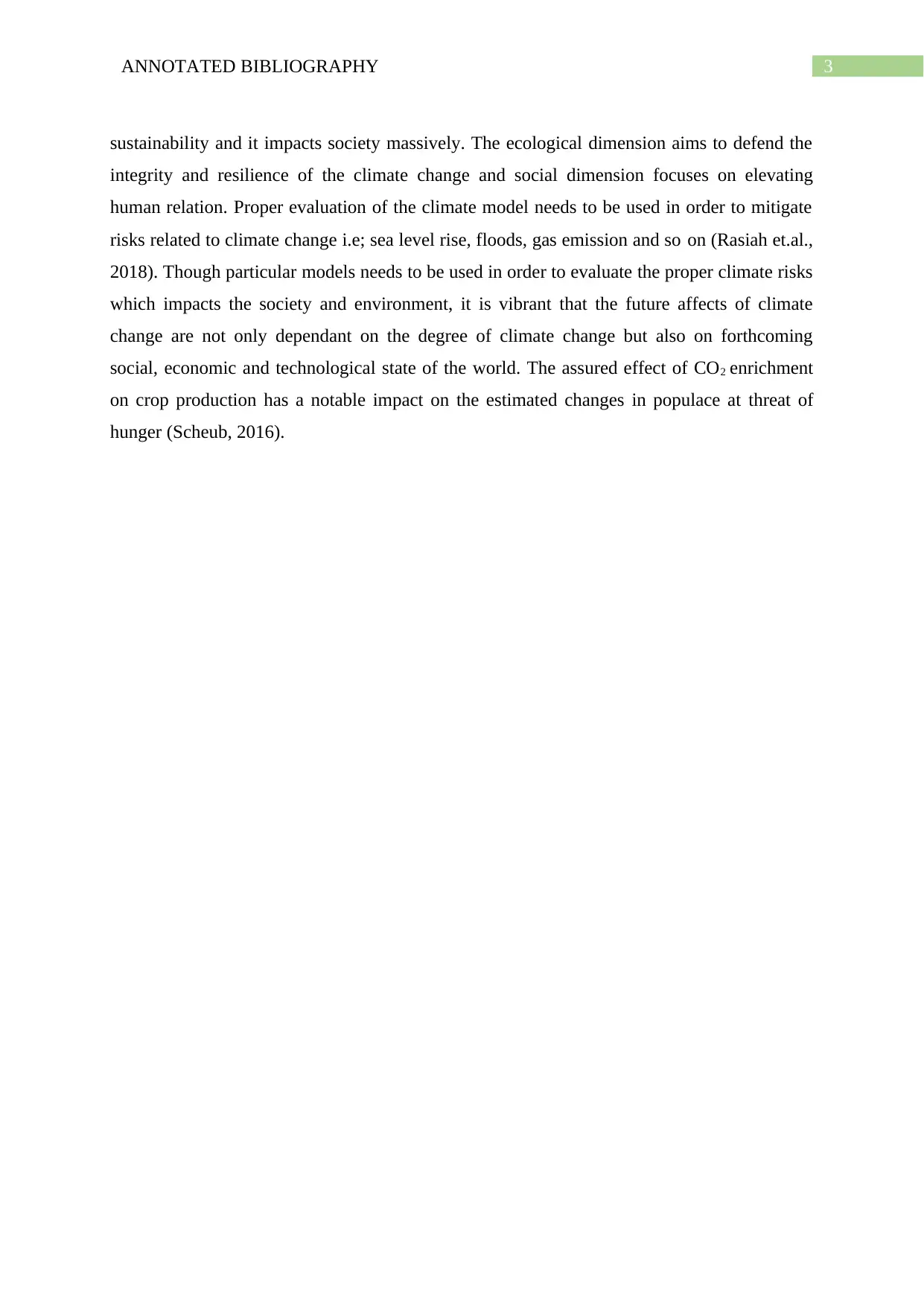
3ANNOTATED BIBLIOGRAPHY
sustainability and it impacts society massively. The ecological dimension aims to defend the
integrity and resilience of the climate change and social dimension focuses on elevating
human relation. Proper evaluation of the climate model needs to be used in order to mitigate
risks related to climate change i.e; sea level rise, floods, gas emission and so on (Rasiah et.al.,
2018). Though particular models needs to be used in order to evaluate the proper climate risks
which impacts the society and environment, it is vibrant that the future affects of climate
change are not only dependant on the degree of climate change but also on forthcoming
social, economic and technological state of the world. The assured effect of CO2 enrichment
on crop production has a notable impact on the estimated changes in populace at threat of
hunger (Scheub, 2016).
sustainability and it impacts society massively. The ecological dimension aims to defend the
integrity and resilience of the climate change and social dimension focuses on elevating
human relation. Proper evaluation of the climate model needs to be used in order to mitigate
risks related to climate change i.e; sea level rise, floods, gas emission and so on (Rasiah et.al.,
2018). Though particular models needs to be used in order to evaluate the proper climate risks
which impacts the society and environment, it is vibrant that the future affects of climate
change are not only dependant on the degree of climate change but also on forthcoming
social, economic and technological state of the world. The assured effect of CO2 enrichment
on crop production has a notable impact on the estimated changes in populace at threat of
hunger (Scheub, 2016).
Paraphrase This Document
Need a fresh take? Get an instant paraphrase of this document with our AI Paraphraser
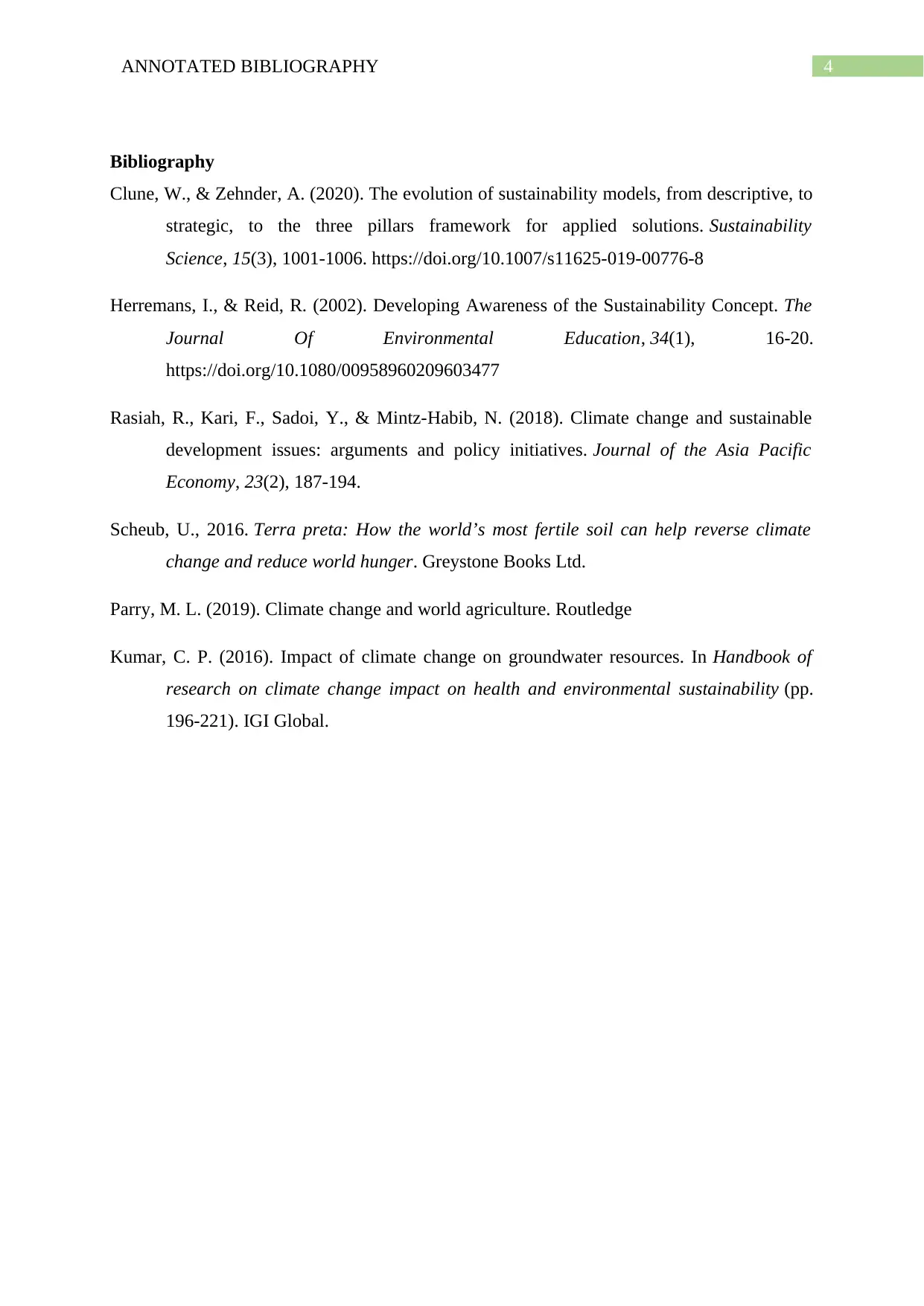
4ANNOTATED BIBLIOGRAPHY
Bibliography
Clune, W., & Zehnder, A. (2020). The evolution of sustainability models, from descriptive, to
strategic, to the three pillars framework for applied solutions. Sustainability
Science, 15(3), 1001-1006. https://doi.org/10.1007/s11625-019-00776-8
Herremans, I., & Reid, R. (2002). Developing Awareness of the Sustainability Concept. The
Journal Of Environmental Education, 34(1), 16-20.
https://doi.org/10.1080/00958960209603477
Rasiah, R., Kari, F., Sadoi, Y., & Mintz-Habib, N. (2018). Climate change and sustainable
development issues: arguments and policy initiatives. Journal of the Asia Pacific
Economy, 23(2), 187-194.
Scheub, U., 2016. Terra preta: How the world’s most fertile soil can help reverse climate
change and reduce world hunger. Greystone Books Ltd.
Parry, M. L. (2019). Climate change and world agriculture. Routledge
Kumar, C. P. (2016). Impact of climate change on groundwater resources. In Handbook of
research on climate change impact on health and environmental sustainability (pp.
196-221). IGI Global.
Bibliography
Clune, W., & Zehnder, A. (2020). The evolution of sustainability models, from descriptive, to
strategic, to the three pillars framework for applied solutions. Sustainability
Science, 15(3), 1001-1006. https://doi.org/10.1007/s11625-019-00776-8
Herremans, I., & Reid, R. (2002). Developing Awareness of the Sustainability Concept. The
Journal Of Environmental Education, 34(1), 16-20.
https://doi.org/10.1080/00958960209603477
Rasiah, R., Kari, F., Sadoi, Y., & Mintz-Habib, N. (2018). Climate change and sustainable
development issues: arguments and policy initiatives. Journal of the Asia Pacific
Economy, 23(2), 187-194.
Scheub, U., 2016. Terra preta: How the world’s most fertile soil can help reverse climate
change and reduce world hunger. Greystone Books Ltd.
Parry, M. L. (2019). Climate change and world agriculture. Routledge
Kumar, C. P. (2016). Impact of climate change on groundwater resources. In Handbook of
research on climate change impact on health and environmental sustainability (pp.
196-221). IGI Global.
1 out of 5
Related Documents
Your All-in-One AI-Powered Toolkit for Academic Success.
+13062052269
info@desklib.com
Available 24*7 on WhatsApp / Email
![[object Object]](/_next/static/media/star-bottom.7253800d.svg)
Unlock your academic potential
Copyright © 2020–2025 A2Z Services. All Rights Reserved. Developed and managed by ZUCOL.





